No video provided.
California Here They Come…How it All Began
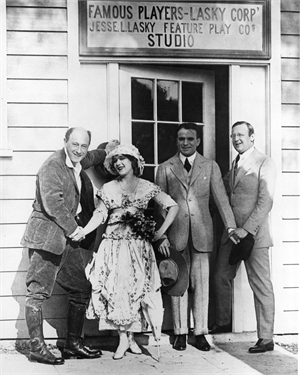
Pioneers Cecil B. DeMille, Mary Pickford, Douglas Fairbanks,
and Jesse Lansky pose in front of a very rudimentary
Famous Players-Lasky Corp Studio in 1916
Most stories about the advent of the film industry in Hollywood begin with Cecil B. DeMille and Jesse Lasky’s arrival in Hollywood. Actually, the seeds were planted much earlier when California native Francis Boggs, an actor, who had moved to Chicago, found work with the Selig Polyscope Film Company. At his suggestion in 1907, the film company shot ocean scenes in Laguna Beach and Selig established a satellite studio, Los Angeles’ first, in Edendale in 1909 but not in Hollywood where movies were prohibited.
Hollywood was established in 1887 by Midwest prohibitionists Harvey Wilcox and his wife, Daeida. Mrs. Wilcox had first learned of the name “Hollywood” when she met Laura (Mrs. John D.) Rockefeller on a train while traveling East. Mrs. Rockefeller told Mrs. Wilcox all about her ranch called Hollywood, outside of Brookfield, Illinois. Daeida so liked the name that when she and Harvey registered the parcel they named it Hollywood. They donated land for churches and schools to promote their conservative values. They also instituted specific prohibitions for the new city – no alcohol could be sold or served, no “movies” could be shown in Hollywood, and no herd of animals numbering more than 200 were to be driven down Prospect Avenue, later to be named Hollywood Boulevard. In 1910 when Hollywood became part of the City of Los Angeles, almost before the ink was dry on the new city charter movie people had come to Hollywood.
D.W. Griffith of New York’s Biograph Film Company brought a small company which included Mary Pickford and Mack Sennett as actors to Hollywood in March of 1910.
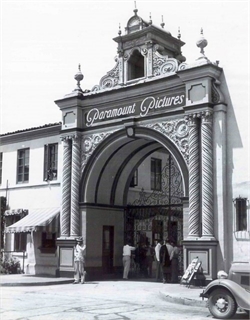
Paramount Pictures grew a bit by the 1930s.
(below) Paramount Pictures today.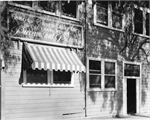
(left) Paramount’s quaint, one-door office in 1920 on Vine St.
Another fortunate train trip would bring about the meeting of David Horsley of the Centaur Film Company of Bayonne, New Jersey and Frank Hoover, a Hollywood photographer who had a studio on Cahuenga Blvd. Both men were on the train West and met and struck up a conversation which led Mr. Hoover to learn that Mr. Horsley needed a film studio in Los Angeles. Hoover suggested the vacant Blondeau tavern as having an ideal layout for a studio – a main, large building, an open courtyard of suitable size for an outdoor stage and ringed by a number of small cabins which could serve as dressing or editing rooms. Like Mr. Griffith, Mr. Horsley would also use local buildings as sets, employing the home of developer H.J. Whitley for one of his early one-reelers. Horsley would make the first film made at a studio in Hollywood, “The Law of the Range” at his new studio. In 1912, Mr. Horsley would join Nestor into the new Universal Pictures company and his Hollywood studio would be leased to the Christie Comedies Company. 1912 would be the same year two other enterprising young men would establish a studio in Hollywood in a barn.
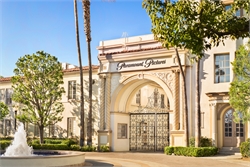 Louis Loss Burns, an experience Native American goods trader and Harry Revier, an aspiring film maker, entered into a partnership establishing rental film studios in Los Angeles. Their first, which was virtually a bungalow and an outdoor stage at Prospect and Sunset, became the Kinemacolor Studio, while their second, a 1901 horse barn in Hollywood at Selma Ave. and Vine St. which they rented from owner Jacob Stern and modified into a studio with an accompanying film lab in May of 1912. Known as the Burns Revier Studio, it just got by as a rental facility. Until December of 1913, when a film company came to Hollywood that would change everything.
Louis Loss Burns, an experience Native American goods trader and Harry Revier, an aspiring film maker, entered into a partnership establishing rental film studios in Los Angeles. Their first, which was virtually a bungalow and an outdoor stage at Prospect and Sunset, became the Kinemacolor Studio, while their second, a 1901 horse barn in Hollywood at Selma Ave. and Vine St. which they rented from owner Jacob Stern and modified into a studio with an accompanying film lab in May of 1912. Known as the Burns Revier Studio, it just got by as a rental facility. Until December of 1913, when a film company came to Hollywood that would change everything.
6917.jpg)
Universal Pictures, 1940.
One of the originals, still going strong.Another California native, Jesse L. Lasky, born in San Francisco, had become a successful theatrical manager and producer following a number of years as a performer. A demand in the theatre for one-act plays led Jesse to Cecil B. DeMille at the urging of his mother, and “California” and a follow-up operetta “In the Barracks” were both successful. But following those plays, Cecil, wanting more individual success, had decided to do something more challenging – like fight in the Mexican Revolution or go big game hunting in Africa. Fearful for his life, Jesse was looking for a parallel challenge for his now best friend Cecil when his brother in law, Sam Goldwyn suggested making movies. Luckily the idea did excite DeMille. So Jesse, Sam and Cecil formed The Jesse L. Lasky Feature Film Company, purchased the movie rights to a successful play “The Squaw Man,” and proceeded with plans to shoot the film in Flagstaff, Arizona. When the film company arrived in Flagstaff, it was raining, mixed with snow and a running range war between the cattlemen and the sheepherders. The film makers decided to go to Los Angeles.
On arriving, Cecil contacted a former theatrical colleague, now a director with the Selig Company and asked about rental studio space. His friend told him about the Burns & Revier Studio (formerly the Sterns barn) and DeMille signed a rental agreement to make “The Squaw Man” in Hollywood.
125.jpg)
Warner Brothers Pictures layout at Sunset and Bronson, 1924.
It would become Sunset-Bronson Studios as seen today. (below)
The Lasky Company made 10x their investment in making “The Squaw Man” which was the first feature length film made in Hollywood. Within a few years, the company merged with Adolph Zukor’s Famous Players and Paramount Pictures distributing company and would become the modern Paramount Pictures Company. Paramount became the first company to produce, distribute, and exhibit their own movies, marking the beginning of the Golden Age of Hollywood and by 1919 there were over 200 production companies in Hollywood.
Land was cheap and plentiful in the Cahuenga Valley and the movie studios were built so the everyone had everything needed 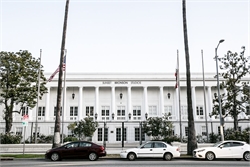 for they needed “on the lot” within the walls of the studio. Each studio had a back lot for shooting outdoors, constructing mammoth sets to film their extravaganzas. With the advent of sound, large soundstages were required. Set builders, electricians, water towers, fire departments and security were all included within the factory walls. As the studios grew, they required administration offices, pre and post production facilities, studio services, plenty of storage, costume makers, carpenters, dressing rooms and food services.
for they needed “on the lot” within the walls of the studio. Each studio had a back lot for shooting outdoors, constructing mammoth sets to film their extravaganzas. With the advent of sound, large soundstages were required. Set builders, electricians, water towers, fire departments and security were all included within the factory walls. As the studios grew, they required administration offices, pre and post production facilities, studio services, plenty of storage, costume makers, carpenters, dressing rooms and food services.
It’s often said that Hollywood isn’t “here” anymore, but nothing could be further from the truth. Not only is it still here with the growth of new media, its flourishing. Not only is Hollywood still here, with the growth of new media, its industry is flourishing. Many of the original studios have been continuously operating—for more than 100 years. Yes, Hollywood is still an industry town as it positions itself for providing entertainment well into the 21st century.
Major “Big Eight” Studios:
Other Studios: